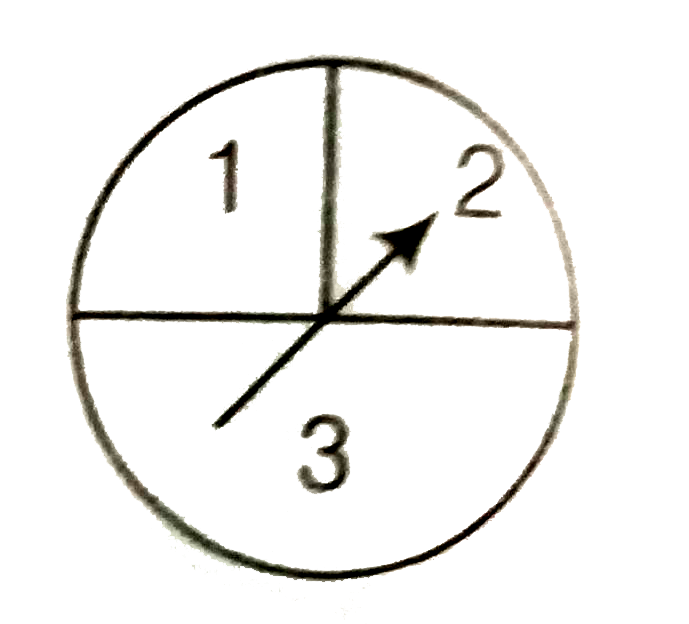A game consists of spinning an arrow which comes to rest pointing at one of the numbers 1,2,3,4,5,6,7,8,9,10,11,12. If the outcomes are equally likely, find the probability that the pointer will point at a prime number.
To find the probability that the pointer will point at a prime number when spinning an arrow that can land on any number from 1 to 12, we can follow these steps:
1. Identify the total outcomes:
The total numbers that the arrow can point to are from 1 to 12. Therefore, the total outcomes are:
Total outcomes=12
2. Identify the prime numbers between 1 and 12:
Prime numbers are numbers greater than 1 that have no divisors other than 1 and themselves. The prime numbers between 1 and 12 are:
- 2
- 3
- 5
- 7
- 11
Thus, the prime numbers in this range are:
Prime numbers={2,3,5,7,11}
3. Count the favorable outcomes:
The favorable outcomes are the prime numbers identified above. There are 5 prime numbers:
Favorable outcomes=5
4. Calculate the probability:
The probability P of an event is given by the formula:
P(event)=Number of favorable outcomesTotal outcomes
Substituting the values we have:
P(pointing at a prime number)=512
5. Final answer:
Therefore, the probability that the pointer will point at a prime number is:
512
The total numbers that the arrow can point to are from 1 to 12. Therefore, the total outcomes are:
Total outcomes=12
Prime numbers are numbers greater than 1 that have no divisors other than 1 and themselves. The prime numbers between 1 and 12 are:
- 2
- 3
- 5
- 7
- 11
Prime numbers={2,3,5,7,11}
The favorable outcomes are the prime numbers identified above. There are 5 prime numbers:
Favorable outcomes=5
The probability P of an event is given by the formula:
P(event)=Number of favorable outcomesTotal outcomes
Substituting the values we have:
P(pointing at a prime number)=512
Therefore, the probability that the pointer will point at a prime number is:
512
Topper's Solved these Questions
Similar Questions
A game consists of spinning an arrow which comes to rest pointing at one of the numbers 1,2,3,4,5,6,7,8,9,10,11,12. If the outcomes are equally likely, find the probability that the pointer will point at an even number.
View SolutionA game consists of spinning an arrow which comes to rest pointing at one of the numbers 1,2,3,4,5,6,7,8,9,10,11,12. If the outcomes are equally likely, find the probability that the pointer will point at a number less than or equal to 9.
View SolutionA game consists of spinning an arrow which comes to rest pointing at one of the numbers 1,2,3,4,5,6,7,8,9,10,11,12. If the outcomes are equally likely, find the probability that the pointer will point at a number between 3 and 11.
View SolutionA game consists of spinning an arrow which comes to rest pointing at one of the numbers 1,2,3,4,5,6,7,8,9,10,11,12, as shown below.

If the outcomes are equally likely, find the probability that the pointer will point at :
(i) a number greater than 8.
View SolutionA game of chance consists of spinning an arrow which comes to rest pointing at one of the numbers 1, 2, 3, 4, 5, 6, 7, 8 (See Fig. 131), and these are equally likely outcomes. What is the probability that it will point at (i) 8? (ii) an odd number? (iii) a number greater than 2? (iv) a number less than 9?
View SolutionA game of chance consists of spinning an arrow which comes to rest pointing at one of the numbers 1,2,3,4,5,6,1,8 (see Figure), and these are equally likely outcomes. What is the probability that it will point at(i) 8?(ii) an odd number?(iii) a number greater than 2?(iv) a number less than 9?
View SolutionA game consists fo spining an arrow which come to rest pointing at one of the number 1,2,3,4,5,6,7,8,9, 10,11,12. Find the probability that the point at (i) a prime number, (ii) a number less than or equal to 9, (iii) a number between 3 and 11.
View SolutionA game consists of spining an arrow which comes to rest pointing at one of regions (1,2 or 3) (see figure). Are the outcomes 1,2 and 3 equally likely to occur? Give reason

View SolutionA game of change consists of spinning an arrow which is equally likely to come to rest pointing to one of the number, 1, 2, 3, .., 12 as shown in Fig. 13.3. What is the probability that it will point to: (FIGURE) (i) 10? (ii) an odd number?
View SolutionA game of chance consists of spinning an arrow which is equally likely to come to rest pointing to all of the numbers 1, 2, 3, ...,12. What is the probability that it will point to (i) 10 (ii) an odd number (iii) a number which is multiple of 3?
View Solution
